The parish still manages others, such as the beautiful statues, mosaics and historical freeze dipicting the 2000 year history of Romania.All members are invited to treasure and preserve our heritage and help us augment it to leave the future generations a solid understanding of their roots and be proud of their Romanian ancestry.
The Historical Frieze of the Romanian Nation Introduction
It is often said that St. Mary’s Romanian Orthodox Cathedral is the most prominent Cultural Center among the Romanian parishes in America. Fact is that this oldest parish in the USA has been blessed to be the repository of unique cultural treasures, today displayed partially under the aegis of the Romanian Ethnic Art Museum and partially by the parish. For this and many other reasons, a visit to St. Mary’s Cathedral offers an extraordinary opportunity to learn about Romania’s soul and her rich and unforgettable history. In fact, the very “raison d’etre” of this presentation is to make known and stimulate clergy, teachers and parents to inculcate in the hearts of their children a deeper knowledge and a greater love for their ancestors great past.
Thousands of visitors come to St. Mary’s year round. Some of them are pilgrims, who come for the religious services; others come occasionally to weddings or other similar events and many come by the busloads to visit this oasis of Romanian culture located at the gateway of Lake Erie. Many scholars and students, U.S. ambassadors to Romania, friends of the Romanian people and visitors from Romanian came through the doors of this church from its inception to our days. They are always impressed with the modern “Maramures style” church, designed by architect Haralamb Georgescu, and then executed by American Romanian architect Nick Tekushan, in 1960. Its high steeple dominates Cleveland’s West Park. Even more, they leave this spiritual and cultural center enriched by the beautiful icons, mosaics, paintings, sculptures, photo displays and the exquisite display of ethnic costumes they see.
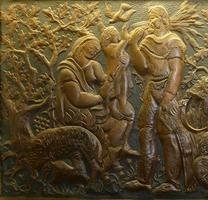 A Centennial Garden will be completed in honor of this event later
this year along with other cultural events. Among them, we list the
Exhibition of the Romanian Ethnic Art Museum at Beck Art Center in
Lakewood and the unveiling of the statue of George Pomutz, a Romanian
General of the Civil War (1862-65). The members of the parish are
enthusiastically undertaking a project of $300,000 for repairs and
development.
A Centennial Garden will be completed in honor of this event later
this year along with other cultural events. Among them, we list the
Exhibition of the Romanian Ethnic Art Museum at Beck Art Center in
Lakewood and the unveiling of the statue of George Pomutz, a Romanian
General of the Civil War (1862-65). The members of the parish are
enthusiastically undertaking a project of $300,000 for repairs and
development.The Authors and History of the Frieze Itself Among the wide spectrum of quality materials on display, the copper Frieze of the Romanian Nation stands as a testimony to the plight and glory of the Romanian nation. This historical frieze depicts the history of Romania, beginning with the pre-Roman times and ending with the year 1938, when king Carol-II was ruling, covering almost two millennia of history. Interested to make it known to the world, the Romanian government commissioned this base-relief historical frieze with Mac Constantinescu (a pseudonym for Mihai Filip), an artist famous for monumental, decorative sculpture. He is known in Romania for many works, especially for having authored “Tataroaica” of Mangalia and the façade of the faculty of Legal Sciences, in Bucharest.
According to Fr. Vasile Hategan, “it took 2 Romanian artisans nearly 2 years to laboriously hammer each separate item by hand”. The work, as known today, measures of art 30 m long and 1.20 m tall, and it is superbly hammered in copper. The selection of the historical events flows in chronological order, covering almost two thousand years of history in the Romanian lands. Now, at the end of the second millenium of the Christian era, I truly believe that for the Romanian culture, this frieze - which condenses the story of a nation - gains a renewed testimonial value, becoming a symbol of a millennial dimensions.
Executed in segments and mounted like the parts of a giant puzzle, the work has been originally displayed in the Romanian Pavilion of at the World’s Fair in New York (1939), adorning then the walls of the balconies in the main hall. Underneath every segment of the display, the explanation of the frieze had been written in large print, on the walls. Thus, the entire hall was dominated by this overpowering display of history and continuity in the life of a nation, otherwise little known in the west.
The sources that describe the Romanian Pavilion as well as the visitors still living today in the Romanian community describe it as truly outstanding achievement. Architect G. M. Cantacuzino realized the pavilion and architect Doicescu did the Romanian House. Many representative artists contributed their works to this international event. Among them are: C. Medrea (Statuary Group), Oscar Han (Freedom and Democracy, today in Cleveland), Onofreiu, Mac Constantinescu (the Frieze, today in Cleveland), Ioan Jalea (Statue of Romanian Princess symbolizing Romania, today in Cleveland), Milita Patrascu (ceramic work, partially in Cleveland), Lena Constante, Dem Demetrescu, Jean Steriade (Moasaic: The Romanian Fairy Tail of the White Prince, today in Cleveland); and many others. One could say that Romania sent to New York the best they had at that time. The Pavilion’s façade was executed in Ruschita alabaster, some carved and some lovely incised with the coat of arms of the Romanian provinces Muntenia, Moldova, Transylvania, Banat, Basarabia, Crisana, Maramures, Dobrogea. Some of these pieces are also in Cleveland. Sadly, much of it has been destroyed in the fire of the social hall of St. Mary’s, in 1973.
Continuing the list of notable personalities that bring a special aura to the frieze and the 1939 World’s Fair, we must remember the famous Professor Dimitrie Gusti, who has been assigned as the general manager of the exhibition. Then, George Enescu conducted three outstanding symphonic concerts during the week of the Romanian music. Other celebrities such as the Grigoras Dinicu orchestra and the immortal folk interpreter and singer, Maria Tanase, brought to life the Romanian soul here, on American soil. How wonderful it must have been to have all these performances in the ambiance created by the Historical Frieze of the Romanian Nation, the Dioramas of the Romanian Village and the other effects intended to portray a progressive country. For more accurate presentations on the World’s Fair, the reader may check the bibliography given at the end of this presentation.
Upon the closing of the World’s Fair, the Frieze has been brought to Cleveland by Fr. John Trutza, who also obtained the other items present now in Cleveland. A special meeting held on November 3rd, 1940 decided to accept the offer of the Romanian Government of the Romanian House and Pavilion at the World’s Fair. Fr. Trutza’s dream was to use the marble for the monumental cathedral he envisioned before his premature death, in 1955. When the parish moved to the present location, the Frieze has been stored for 30 years, along with many other valuable items, in the basement of the social hall, which then burned to the ground in 1973. Many church valuables and “much artwork from the World’s fair were lost”(Fr. Vasile Hategan). Although damaged, the miracle is that the frieze survived, having been pulled out of the smoky ruins by church members, who appreciated its value.
Through the vision of Fr. Hategan and the expert restoration, executed under the direction of artist Ilie Hasigan, in 1974, this unique work of art and history has been incorporated by architect Nick Tekushan in the new social hall of the church and became its “main feature”
. The 30 m. long historical copper frieze covers both sides of the upper walls of the hall and – by its monumental style - it stirs the curiosity of anyone who enters through the doors of this edifice. This story in images is being narrated in 26 episodes or base-relief groups medallions, separated from each other by symbolic oak trees - a symbol of endurance and longevity of the Romanian people.
1. Dacia (old name of Romania), Before the Roman Conquest
Mac Constantinescu’s narration in copper first presents a young Dacian mother washing a baby with love and tender care. A strong man stands in front of her and carries a bundle of wheat on his right shoulder, while holding the sickle by his left hand. A flying dove, the grazing mother sheep and a suckling lamb symbolize their love for peace and agriculture. The grape vine indicates that this image is pre-Roman and leads us to think of the king Burebista, who out of religious reasons extirpated the vine totally during Cesar’s time (44 AD). An ancient oak tree in the background indicates the deep Thracian ancestry of the Dacians. They are mentioned both in the Bible and by the Greek historian Herodotes (514 A.D.), who qualifies the Dacians as “the most brave” among the Thracians.
2. The Roman Conquest (101-2;105-6)
Following another symbolic oak tree, which marks a new generation, the forceful Roman crossing over the Danube is depicted. Having their eyes directed on the gold and salt mines of Dacia, emperor Trajan defeated it in two wars, which are described by Roman historian Dio Casius . The famous Syrian architect Apolodorus built a bridge over the Danube, at Drobeta –Turnu Severin. It’s ruins still stand today. King Decebal buries the treasury of the state at the bottom of the Sargetia river, near the capital of Sarmisegetuza (in today’s Transylvania), and chooses suicide over captivity. The cruelty of the conquest is vividly illustrated.
The strong Roman infantry and chivalry trample the poorly armed Dacian men, over 5 years of siege. The frieze offers precious details of costumes, army uniforms, military insignia and even the details of the Roman Bridge. The Dacians finally submit themselves to Trajan, who is shown being crowned with the laurels by a goddess of victory. Men, women and children are accepting his triumph.
According to historian Cassius Dio, 40 days Rome was in festivities, following this victory. Forum Traiani and the Column describing the Dacian Warrs still stand today in Rome, in a witness to this event. That is the “birth certificate” of the Romanian nation. Another monument has been raised in Adamclisi (Romania), as it appears in the background of this medallion. Dacia became the most advanced promotorium in the Northeast of the Roman Empire, taking the name of Dacia Felix (Happy Dacia), while Trajan took for himself the title “Dacicus”. Beautiful Dacian statues could be also seen at the Vatican museum, in Rome. During the Roman occupation (106-271 AD) the Dacians adopted the Latin language and were Christianized, becoming a Latin island of population surrounded later by Slavs and Hungarians. Throughout their entire history they maintained their language and Faith. The archeological monuments attest all this, as American historian Kith Hitchins showed in his book “The Dacian Stones Speak”.
3. The Roman Withdrawal
On 271, under the pressure of the Germanic tribes, Emperor Aurelianus withdrew his armies South of the Danube. He left behind him in this Romanized part of the world, a new nation, which by the time it reached its own identity and ethos was already Christian and speaking a popular Latin dialect, Romanian. The saints produced by this population in the 5th century (Ioan Cassian, Niceta de Remesiana) and the numerous archeological discoveries support all of this.
With the departure of the Roman army and administration, the Happy Dacia becomes an easy prey to the nomadic barbarian invaders.
4. The Dark Middle Ages
The frieze depicts the struggles of Romanians to defend their land against the waves of Goths (271), the Huns (375-453), the Gepides (453-566), the Avars (566-799) and then the Slavic tribes. The Slavs were less cruel than the Far Eastern invaders and they settle and sometimes they were assimilated among the Romanians. By 679 the Vologars (Bulgarians) settled South of the Danube. They were followed by the Magyars, who settled in Pannonia (840-890), and then by Petchenegs, Cumans and the cruel Tartars in 1241. This is a time of destruction and turmoil, known in the history for the entire Europe as the “dark millenium”. Nevertheless, life continued on this land, in times of peace as well as in times of wars. The Byzantine chronicles (6th century), the Chronicle the Secretary of Hungarian King Bella 3rd, the Slavic chronicles (11th century) as well as the Nibelungenlied of the time mention the “Vlachos”(Romanians) as continuous presence and reality, on this lands.
The Church History also attests the fact that bishops from these territories attended ecumenical councils and produced a series of saints. During such times, Romanians started to have their first political organizations, having local dukes (voevods) and using the “Jus Wallahicum”- the Romanian law). In Transylvania, we know of three such “voevodates” and many “lands” (“}\ri”), which were gradually overpowered by the Arpadian Hungarian Dinasty at the end of the first millenium. Between 1185-1257, there was even a Romanian – Bulgarian state, a time when much of the Church Slavonic language was introduced in the Orthodox Church. The legends and fairy tales from this period are countless and extremely resourceful.
5.
The Formation of the First Romanian Principality –
Wallachia (Muntenia)
Following another symbolic oak tree, the Basarab I dynasty
is represented. The king wears armory and caries the long,
wide sword. On the herald the coat of arms is made of an
eagle holding the cross in its beak. Behind stand the royal
church of Curtea-de-Arges (1281) – at that time, capital
of Wallachia - of which the sacrifice legend of Master Manole
is connected. Rich crops of wheat are also shown as main
branch of economy of these Romanian plains.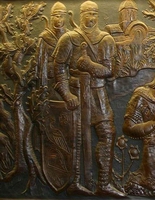
6. Establishment of the Moldavian Principality (1353-59)
The frieze then features the legendary prince Dragos of Maramures who settles in Moldova while hunting buffalo. Ever since the buffalo head became the coat of arms of this eastern Romanian province so rich in history, monasteries. The frieze is very accurate in depicting the uniforms and arms of the time.
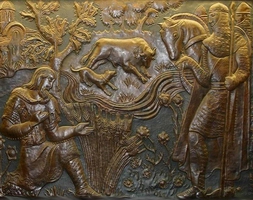
8. The Great and Holy Steven, Prince of Moldova (1457-1504) As it goes on to the 15th century, the artist hammered a representative image about the Musatini dynasty: Steven, who fought 42 wars to defend his land from the Turks, receives the title of “Defender of Christianity” from the envoy of Pope Sixtus 4th. In Venice at this time, Moldavia became known as the other Romanian” - “altera Wallachia”. He also fought with the Polish kings, setting the borders at Cosmin Woods. This comes soon after the attempt of reunification of the Church at Florence (1459). Steven has erected 42 churches and monasteries and in 1993 has been canonized a saint and defender Orthodoxy. Some of the oldest Romanian shrines date from his time: Putna, Neamt, Humor, Dragomirna, etc. At St. Mary’s, there are also two imposing mosaics representing him and his wife Maria and his son, Peter Rares with his princess. By this time, Antonio Bofini, a historian established at the Court of Hungary, noted “The Romanians descended from the Romans, a fact attested down to our times by their language, who although surrounded by such diversity of barbarian peoples, could not be superceded”
9. Michael the Brave, First to Unite the Romanian Kingdom (1593-1601)
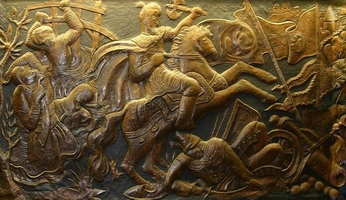 A short but glorious icon is given to Mihai Viteazul. He
is truly ‘brave” for having fought against the
Turks(Calugareni, 1595) and then occupy Moldova (1600) and
Transylvania (1599-1600). He defeated the Hungarians, at
Selimbar, and triumphantly entered as the first king of
the unified Romanian provinces, in Alba Iulia (1600). The
frieze shows him riding a furious horse, wearing traditional
Romanian hat “caciula” and holding a short ax
in his left hand. Alba Iulia and Suceava fortresses are
dominated by his banner, while at the feat of his horse
lay both defeated Turks and Hungarian nobles. The last “cowardly”
assassinated him in 1601, at Turda. Then he was beheaded
with cruelty. His head has been secretly brought to Tirgoviste,
where it is buried, at Dealul Monastery. His historical
unification of Romania marks the beginning of along process
that will only be finally consolidated, on December 1st,
1918.
A short but glorious icon is given to Mihai Viteazul. He
is truly ‘brave” for having fought against the
Turks(Calugareni, 1595) and then occupy Moldova (1600) and
Transylvania (1599-1600). He defeated the Hungarians, at
Selimbar, and triumphantly entered as the first king of
the unified Romanian provinces, in Alba Iulia (1600). The
frieze shows him riding a furious horse, wearing traditional
Romanian hat “caciula” and holding a short ax
in his left hand. Alba Iulia and Suceava fortresses are
dominated by his banner, while at the feat of his horse
lay both defeated Turks and Hungarian nobles. The last “cowardly”
assassinated him in 1601, at Turda. Then he was beheaded
with cruelty. His head has been secretly brought to Tirgoviste,
where it is buried, at Dealul Monastery. His historical
unification of Romania marks the beginning of along process
that will only be finally consolidated, on December 1st,
1918. 10. Neagoe Basarab (1512-1521)
Neagoe Basarab is the founder of the superb Curtea de Arges church, painted by Dobromir, with an iconography in a true Romanian style, the royal necropolis or burial place. I do not know if this has been originally intended so or a mistake may have occurred when the Frieze has been rearranged in 1974, but Neagoe Basarab should have proceeded Michael the Brave, according to true chronology. This concludes the first half of the frieze, as it stands today on the southern wall of St. Mary Cathedral’s hall.
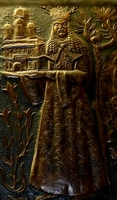
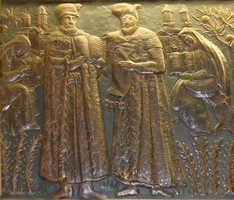
11. Rulers of Wallachia & Moldova Matei Basarab (1634-1653) and Vasile Lupu (1632-1654)
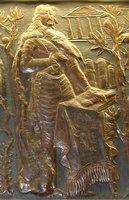
This ruler had a short-lived kingship, but he opposed the Turks and sided with Tsar Peter the Great. Defeated at Stanilesti (1711) he lived the rest of his life in exile. A polyglot and an erudite writer, historian and geography writer he became a member of the Berlin Academy, in 1712. It’s symbol appears on the frieze. He wrote Descriptio Moldaviae and a Chronicle of the Whole Romanian Country which later was dinvided in Moldavia, Wallachia and Transylvania. He also wrote a history of the Ottoman Empire. He is also known as an accomplished theoretician of music.
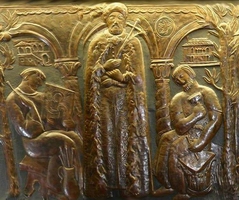
13. The Saint and Martyr King, Constantin Brancoveanu (1688-1714)
Brancoveanu is shown holding the cross of martyrdom. Behind him there are monks painting and writing, as well as the Mogosoaia Palace. The first symbol points out to the blossoming of the literature, iconography and printing during his rule. The typical peasant house that can be seen on the background suggests to the viewer that he is the one credited for a typical Romanian architectural style, called “Brancovenesc”. (The Horezu, Antim and Sambata de Sus monasteries have been built.Constantin Brancoveanu in such style). Brancoveanu and his four children Constantin, Stefan, Radu and Matei and his secretary Ianache have been beheaded in Istambul for their refusal to embrace the Islam (August 15, 1714). They were all canonized as saints in 1993. From 1714 to 1821, the Turks from Phanar appointed all foreign rulers. Thus, this period became known as one of the harshest times of corruption and bribery in the history of Romania. By 1821, the Revolt of Tudor Vladimirescu brought the “Phanariotes era” to an end and open the door to the modern history of the country.
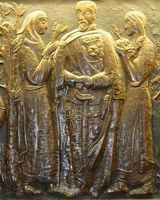
Surrounded by two peasant women, symbols of Wallachia and Moldova, King Cuza holds the sword. He has been elected simultaneously in both provinces and the great powers recognized his rule. The name “Romania” has been adopted as the official name of the land (1862). On 1966, he was usurped by a complot and lived the rest of his life in exile. His rule is tied to the abolition of the slavery of gypsies, in 1862, at the same time with President Lincoln. He is also credited with the establishment of the first financial institutions and the post office; he secularized the Church lands owned by the Greeks of Phanar. He issued the first Romanian stamp, representing the buffalo head (extremely rare and valuable). To safeguard the unity of Romania and its recognition by the western powers, a western prince has been invited by the political parties to rule the country.
15. The Beginning of the Hohenzollern Dynasty (1966-1947)
A dynamic presentation of the rule of Carol I (1866-1916) shows the king standing straight, with the Turkish cannons and flags bowed under his feet, while an angel from on high bestows on him the crown made from the steel of the enemies cannons. This indicates that after the independence war (1877), Romanian was proclaimed a Kingdom. By him, seats Queen Elizabeth, also known by her pen name, as Carmen Sylva (the song of the forest), dressed in Romanian peasant outfit, contemplating the monumental bridges over the Danube build under the direction of Anghel Saligny. At the time, this was the longest bridge in Europe. On the background on could see the majestic Peles Castle, built at this time in the Carpathian Mountains.
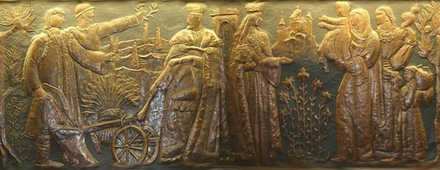
16. King Ferdinand and Queen Marie (1914-1927)
On 1916, upon the death of the childless Carol I, his nephew Ferdinand succeeded him to the throne. He appears robed with the royal mantle and crown, encouraging the agriculture, development of oil fields. A soldier carrying the laurels of victory shows that he lead Romanian into the war, on the side of the Allies. L’Ark de Triumph sculpted behind suggests the victory as well as unification of Romania with Transylvania (Dec. 1, 1918). Romanian Americans supported and fought for this unity. Much has been written about this in the American Romanian press, and especially in the America, Romanian American Review and Romania Herritage Center’s Bulletin. Queen Marie, the famous poet and diplomat, a British princess with ties to all major European dynasties, majestically stands by him. She pays attention to the women of the land, whom she sustained as she did the wounded in the war and the social care. In front of her there is a field of lilies, symbol of resurrection and her favored flower. Memorabilia from this beloved queen – who put united Romania on the world map in a brilliant way - are present in the museum sheltered by St. Mary’s.

After the death of Ferdinand, since King Michael was under age - the country was lead by Regency. The frieze reflects the economic boom of the 1930s. All social categories and major trades are presented around a woman symbolizing Romania, holding an angel on her left palm and on the right hand embracing a book engraved with the letter “C”. This is the first democratic Constitution of 1923. In front of this woman stand a child in uniform, saluting the King and holding the banner of the “Strajerii”, corresponding to the Boy Scouts. King Carol II is shown in front of the minor regent Michael, taking the oath. Since the frieze has been brought into existence during his rule, more space has been dedicated to this time. A girl offers him a bouquet of flowers. The peasants blue color workers and surround him in unity of mind. Behind the king, one could see the Cotroceni Palace. A marble column from the Acropolis, adorned with the sculpted crown of Romania and originally with his statue holding his son, His Majesty King Michael could be seen today on the complex of St. Mary’s. This statue has been transformed into the image of Mother of God, holding in her arms the Lord.




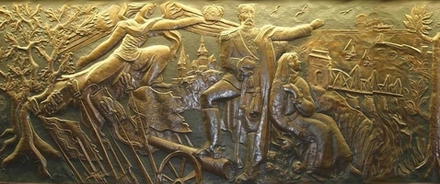




No comments:
Post a Comment